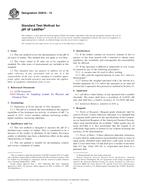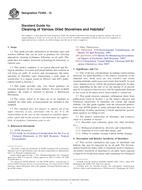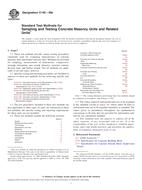1.1 The purpose of this standard is to provide uniform test methods for the determination of strain gauge performance characteristics. Suggested testing equipment designs are included.
1.2 Test Methods E 251 describes methods and procedures for determining five strain gauge parameters:
| Section | |
| Part I–General Requirements | 7 |
| Part II–Resistance at a Reference Temperature | 8 |
| Part III–Gauge Factor at a Reference Temperature | 9 |
| Part IV–Temperature Coefficient of Gauge Factor | 10 |
| Part V–Transverse Sensitivity | 11 |
| Part VI–Thermal Output | 12 |
1.3 Strain gauges are very sensitive devices with essentially infinite resolution. Their response to strain, however, is low and great care must be exercised in their use. The performance characteristics identified by these test methods must be known to an acceptable accuracy to obtain meaningful results in field applications.
1.3.1 Strain gauge resistance is used to balance instrumentation circuits and to provide a reference value for measurements since all data are related to a change in the gauge resistance from a known reference value.
1.3.2 Gauge factor is the transfer function of a strain gauge. It relates resistance change in the gauge and strain to which it is subjected. Accuracy of strain gauge data can be no better than the precision of the gauge factor.
1.3.3 Changes in gauge factor as temperature varies also affect accuracy although to a much lesser degree since variations are usually small.
1.3.4 Transverse sensitivity is a measure of the strain gauge’s response to strains perpendicular to its measurement axis. Although transverse sensitivity is usually much less than 10 % of the gauge factor, large errors can occur if the value is not known with reasonable precision.
1.3.5 Thermal output is the response of a strain gauge to temperature changes. Thermal output is an additive (not multiplicative) error. Therefore, it can often be much larger than the gauge output from structural loading. To correct for these effects, thermal output must be determined from gauges bonded to specimens of the same material on which the tests are to run; often to the test structure itself.
1.4 Bonded resistance strain gauges differ from extensometers in that they measure average unit elongation (ΔL/L) over a nominal gauge length rather than total elongation between definite gauge points. Practice E 83 is not applicable to these gauges.
1.5 These test methods do not apply to transducers, such as load cells and extensometers, that use bonded resistance strain gauges as sensing elements.
1.6 Strain gauges are part of a complex system that includes structure, adhesive, gauge, leadwires, instrumentation, and (often) environmental protection. As a result, many things affect the performance of strain gauges, including user technique. A further complication is that strain gauges once installed normally cannot be reinstalled in another location. Therefore, gauge characteristics can be stated only on a statistical basis.
1.7 This standard does not purport to address all of the safety concerns, if any, associated with its use. It is the responsibility of the user of this standard to establish appropriate safety and health practices and determine the applicability of regulatory limitations prior to use.
Product Details
- Published:
- 04/01/2009
- Number of Pages:
- 20
- File Size:
- 1 file , 340 KB


